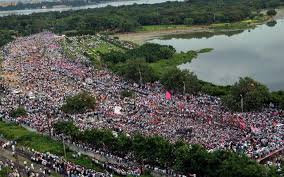The Telangana Movement refers to the socio-political agitation and demand for a separate statehood for the region of Telangana within the larger Indian state of Andhra Pradesh. The movement gained significant momentum in the early 21st century and ultimately resulted in the formation of the state of Telangana in 2014. The movement was characterized by mass protests, strikes, and political mobilization, driven by historical, cultural, economic, and political factors.

Background: Telangana is a region located in the southern part of India, with Hyderabad as its largest city and capital. The movement for a separate Telangana state had its roots in decades of perceived neglect and disparities between the Telangana region and the more prosperous coastal Andhra region within Andhra Pradesh.
Historical and Cultural Factors: Many Telangana residents felt that their distinct cultural identity and historical background were not adequately represented in the larger state of Andhra Pradesh. They argued that their traditions, language, and customs were different from those of the coastal Andhra region.
Economic Disparities: Economic development, infrastructure, and job opportunities were often concentrated in the coastal Andhra region, particularly in the city of Hyderabad. Telangana, on the other hand, faced relative underdevelopment and fewer opportunities for growth.
Political Representation: The perception of political underrepresentation also fueled the movement. Many Telangana residents believed that political power and decision-making were disproportionately controlled by leaders from the coastal Andhra region.
Key Phases of the Movement:
- Origins and Early Demands: The demand for a separate Telangana state had existed for several decades, with intermittent protests and movements. However, the movement gained momentum in the early 21st century, with renewed demands for statehood.
- K. Chandrashekar Rao and TRS: The Telangana Rashtra Samithi (TRS), a regional political party led by K. Chandrashekar Rao, played a significant role in organizing and leading the movement. The party advocated for the creation of a separate Telangana state.
- Mass Protests and Agitations: The movement saw widespread protests, strikes, and rallies, often resulting in disruptions to daily life and economic activities. Students, political activists, and ordinary citizens participated in large numbers.
- Fast-Unto-Death: K. Chandrashekar Rao and other leaders of the movement undertook hunger strikes and fasts unto death to draw attention to the demand for a separate state.
- Government Response: In response to the intense agitation and growing public sentiment, the Indian government, under the leadership of the United Progressive Alliance (UPA) coalition, eventually agreed to the demand for a separate Telangana state.
Outcome: On June 2, 2014, the state of Telangana was officially formed, becoming India’s 29th state. Hyderabad, which had been the joint capital of Andhra Pradesh and Telangana, became the capital of the newly formed Telangana state.
The Telangana movement represents a significant chapter in India’s history, illustrating how regional disparities and demands for identity and autonomy can lead to substantial political and administrative changes. While the formation of Telangana addressed some of the grievances of the movement’s supporters, it also raised questions and concerns about potential implications for other regions and the overall governance structure of the country.